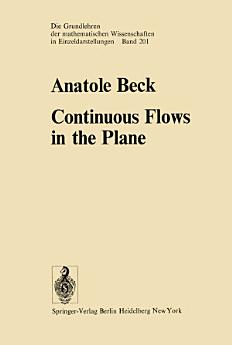Continuous Flows in the Plane
A. Beck
ธ.ค. 2012 · Grundlehren der mathematischen Wissenschaften หนังสือเล่มที่ 201 · Springer Science & Business Media
eBook
464
หน้า
reportคะแนนและรีวิวไม่ได้รับการตรวจสอบยืนยัน ดูข้อมูลเพิ่มเติม
เกี่ยวกับ eBook เล่มนี้
Topological Dynamics has its roots deep in the theory of differential equations, specifically in that portion called the "qualitative theory". The most notable early work was that of Poincare and Bendixson, regarding stability of solutions of differential equations, and the subject has grown around this nucleus. It has developed now to a point where it is fully capable of standing on its own feet as a branch of Mathematics studied for its intrinsic interest and beauty, and since the publication of Topological Dynamics by Gottschalk and Hedlund, it has been the subject of widespread study in its own right, as well as for the light it sheds on differential equations. The Bibliography for Topological Dyna mics by Gottschalk contains 1634 entries in the 1969 edition, and progress in the field since then has been even more prodigious. The study of dynamical systems is an idealization of the physical studies bearing such names as aerodynamics, hydrodynamics, electrodynamics, etc. We begin with some space (call it X) and we imagine in this space some sort of idealized particles which change position as time passes.
ให้คะแนน eBook นี้
แสดงความเห็นของคุณให้เรารับรู้
ข้อมูลในการอ่าน
สมาร์ทโฟนและแท็บเล็ต
ติดตั้งแอป Google Play Books สำหรับ Android และ iPad/iPhone แอปจะซิงค์โดยอัตโนมัติกับบัญชีของคุณ และช่วยให้คุณอ่านแบบออนไลน์หรือออฟไลน์ได้ทุกที่
แล็ปท็อปและคอมพิวเตอร์
คุณฟังหนังสือเสียงที่ซื้อจาก Google Play โดยใช้เว็บเบราว์เซอร์ในคอมพิวเตอร์ได้
eReader และอุปกรณ์อื่นๆ
หากต้องการอ่านบนอุปกรณ์ e-ink เช่น Kobo eReader คุณจะต้องดาวน์โหลดและโอนไฟล์ไปยังอุปกรณ์ของคุณ โปรดทำตามวิธีการอย่างละเอียดในศูนย์ช่วยเหลือเพื่อโอนไฟล์ไปยัง eReader ที่รองรับ









